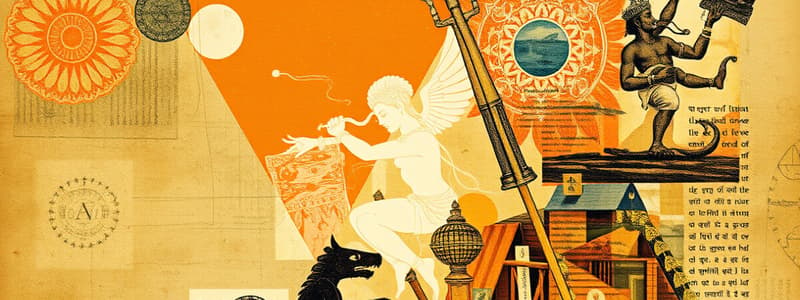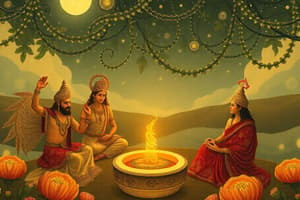Podcast
Questions and Answers
What is one of the most influential ideas in Hinduism?
What is one of the most influential ideas in Hinduism?
- Reincarnation
- Moksha
- Karma
- The universe (correct)
In the Vedic hymns, what is godhead renamed/called?
In the Vedic hymns, what is godhead renamed/called?
Purusa
In the Upanishads, what is godhead renamed/called?
In the Upanishads, what is godhead renamed/called?
Brahman
What are the main Hindu scriptures?
What are the main Hindu scriptures?
What were the Vedas?
What were the Vedas?
What is Atman?
What is Atman?
How does one reunite with godhead? What is it called?
How does one reunite with godhead? What is it called?
Which part of the Sanskrit is the Bhagavad-Gita a part of?
Which part of the Sanskrit is the Bhagavad-Gita a part of?
What is karma & dharma?
What is karma & dharma?
It is possible to be liberated from the cycle of karma by ending delusion and reaching Enlightenment. Is this a principle of Hinduism, Buddhism, or Gita?
It is possible to be liberated from the cycle of karma by ending delusion and reaching Enlightenment. Is this a principle of Hinduism, Buddhism, or Gita?
Which integrates the older Hindu theory of dharma with the new Buddhist teaching of salvation? Gita, Hinduism or Buddhism?
Which integrates the older Hindu theory of dharma with the new Buddhist teaching of salvation? Gita, Hinduism or Buddhism?
Suffering must be endured and one must exhaust karma to achieve moksha. Is this a principle of Hinduism, Buddhism, or Gita?
Suffering must be endured and one must exhaust karma to achieve moksha. Is this a principle of Hinduism, Buddhism, or Gita?
What did the Brahmi writing system feature?
What did the Brahmi writing system feature?
What is the status of the early Indus-Harrappan writing system?
What is the status of the early Indus-Harrappan writing system?
Hinduism, the primary religion in ancient India, is characterized by what?
Hinduism, the primary religion in ancient India, is characterized by what?
What is the Bhagavad-Gita a part of?
What is the Bhagavad-Gita a part of?
How did Mahatma Gandhi characterize India in the mid-twentieth century?
How did Mahatma Gandhi characterize India in the mid-twentieth century?
What was the primary language used to produce Indian literature into the nineteenth century?
What was the primary language used to produce Indian literature into the nineteenth century?
The earliest works composed in South Asia were hymns organized into four groups called?
The earliest works composed in South Asia were hymns organized into four groups called?
Who established the first Indian empire?
Who established the first Indian empire?
Indo-Aryan culture, which displaced Indus-Harappan culture starting about 2000 BCE, focused primarily on what?
Indo-Aryan culture, which displaced Indus-Harappan culture starting about 2000 BCE, focused primarily on what?
Alternative religious beliefs to Hinduism found expression in which traditions?
Alternative religious beliefs to Hinduism found expression in which traditions?
South Asia, despite its diverse religious & political practices, remains a relatively cohesive what?
South Asia, despite its diverse religious & political practices, remains a relatively cohesive what?
Ancient texts were transmitted orally. What did specially trained 'reciters' depend on?
Ancient texts were transmitted orally. What did specially trained 'reciters' depend on?
What is on Arjuna's war banner?
What is on Arjuna's war banner?
According to Krishna, violence is only acceptable when?
According to Krishna, violence is only acceptable when?
What from the humans nourishes the gods?
What from the humans nourishes the gods?
Where is Arjuna when he suddenly collapses?
Where is Arjuna when he suddenly collapses?
What terrible outcome results from corrupted women during times of war?
What terrible outcome results from corrupted women during times of war?
Which statement reflects the way of Yoga?
Which statement reflects the way of Yoga?
What is Arjuna & his people preparing for at the start of chapter one?
What is Arjuna & his people preparing for at the start of chapter one?
The Blessed One advises Arjuna that his enemies are?
The Blessed One advises Arjuna that his enemies are?
Krishna suggests men can be free from pain by?
Krishna suggests men can be free from pain by?
What does Krishna say is a fate worse than death?
What does Krishna say is a fate worse than death?
When was the Bhagavad Gita written?
When was the Bhagavad Gita written?
Flashcards are hidden until you start studying
Study Notes
Hinduism and the Bhagavad Gita
- One influential idea in Hinduism is that the universe is a vast process of self-generation.
- In Vedic hymns, the godhead is referred to as Purusa, meaning spirit.
- The Upanishads rename the godhead as Brahman, representing the anthropomorphic God of Creation.
- Main Hindu scriptures include the Vedas and Upanishads, with the Vedas consisting of four books of hymns.
- Atman refers to the soul or self seeking to unite with godhead, while moksha is the reunion with the godhead achieved by exhausting karma.
- The Bhagavad-Gita is part of the Mahabharata, addressing dilemmas of karma in challenging situations.
Key Concepts in Hinduism and Related Beliefs
- Karma relates to actions, cause and effect; dharma pertains to duty, law, morality, and obligation.
- Buddhism teaches liberation from karma through enlightenment, while the Gita integrates Hindu dharma with Buddhist salvation teachings.
- Suffering must be endured in Hinduism to achieve moksha, contrasting slightly with Buddhist perspectives.
Historical and Cultural Context
- The Brahmi writing system, which became stable around 250 BCE, included diacritical marks and was written from left to right.
- The early Indus-Harappan writing system remains undeciphered.
- Hinduism, the primary religion in ancient India, is characterized by polytheism, the belief in many gods.
- The earliest compositions in South Asia were hymns organized into the Vedas, with the Maurya dynasty establishing the first Indian empire.
Societal Practices and Values
- Indo-Aryan culture, emerging around 2000 BCE, emphasized family farming and displaced the earlier Indus-Harappan civilization.
- Jainism and Buddhism represent alternative religious beliefs to Hinduism.
- Despite diverse religious and political practices, South Asia is regarded as a cohesive cultural zone.
Oral Traditions and Literature
- Ancient texts were largely transmitted orally, relying on memorization by specially trained reciters.
- Sanskrit was the primary language of Indian literature, influenced by the Indo-Europeans.
The Bhagavad Gita Narrative
- Arjuna’s war banner features a monkey, symbolizing loyalty and vigilance.
- Violence is only deemed acceptable by Krishna when it involves defending a righteous cause.
- Human sacrifices nourish the gods, highlighting the importance of offerings in Hindu practices.
- Arjuna collapses in his chariot, filled with doubt and moral conflict as he prepares for battle against Dhritarashtra’s forces.
- The consequences of corrupting women during wars lead to the mingling of classes and societal disorder.
Philosophical Insights
- The way of Yoga promotes balance in thought and action, encouraging harmony.
- Arjuna and his people prepare for battle at the start of Chapter One, embodying the struggle against evil.
- Krishna identifies Arjuna's enemies as passion and impulsivity, emphasizing the internal struggle against distraction.
- To be free from pain, Krishna advises dissolving worldly attachments, which can provide spiritual liberation.
- Falling into shame is presented as a fate worse than death, stressing the importance of honor.
Historical Context of the Text
- The Bhagavad Gita was written during the fourth century BCE, encapsulating profound philosophical and spiritual ideas within its narrative.
Studying That Suits You
Use AI to generate personalized quizzes and flashcards to suit your learning preferences.




